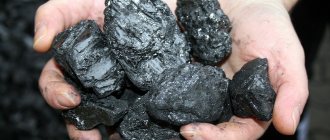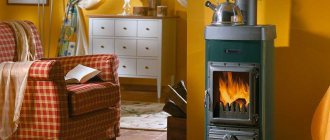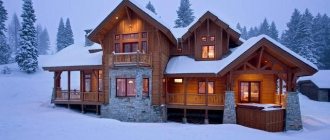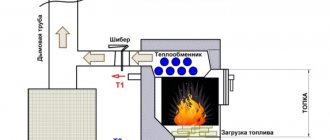Author: Yuriy Fedorovich Kolesnikov, thermal power engineer
The gas furnace is currently of particular interest. Let us immediately make a reservation that what follows does not mean gas cookers and hot water boilers; These are certain types of heating devices using gaseous fuel. Also a special topic is technological gas furnaces for industrial purposes. We are interested, simply put, in household gas stoves.
The cost per unit of heat obtained from natural gas is today much lower than from other sources , including electric heaters. In terms of ease of delivery and consumption, natural gas is second only to electricity, but it can be stored for future use without fear of dampness, bituminization, spontaneous combustion, and other disadvantages of solid and liquid fuels. This situation will continue in the coming decades; in any case, for a time several times longer than the estimated service life of gas heating devices. If you come up with a way to distribute heat throughout the rooms without pipes, radiators and coolant, then gas heating will turn out to be not only economical during operation, but also require 1.2-2 times lower initial costs than traditional water heating. And this method is already known, see below.
We will also take a closer look at gas sauna stoves. A city dweller of average and above average income can afford a maximum of a mini-sauna in his apartment, see fig. But they are produced mainly electric, the steam costs a pretty penny. And to get permission for gas - as they say, it won’t be late at night. Plus - destruction in the apartment from construction and installation work.
In general, those who like to take a steam bath in their bathhouse no longer go there, but go out on weekends. But firewood “from the forest,” alas, is a thing of the past. In the vicinity of holiday villages, everything is picked clean. At least scrape together enough for barbecue, but for a sauna you need several armfuls of firewood. And there’s also the time factor: it takes at least 2-3 hours to heat the bathhouse with wood until it’s ready. Steam as a family in shifts – 3-4 hours. You can’t fuss around while you’re steaming, otherwise the bath will only do harm; that’s another 2-3 hours of rest. How much is left for other chores and entertainment if an overnight stay is not planned? And even if it is planned, then out of 2 days off, only 1 is left for household chores. What does a gas sauna stove provide in this case? Quite a few:
- Lighting up the stove is instantaneous; About an hour is saved on fuel transfer alone.
- Women and children can steam already 30-40 minutes after starting the stove (if it is of a special design for gas, see below), and 1.5-2 hours will be enough for the whole family; the total gain in time is 3-4 hours, i.e. an extra half day for housekeeping.
- The price of gas for a bathhouse is comparable to that of solid fuel, but what is more convenient to carry – a propane cylinder or a bag and a half of coal? The question is rhetorical.
What is often forgotten
Gaseous fuel has a remarkable property: its combustion rate can be arbitrarily high, even to the point of detonation. They fight the danger of an explosion by adding a fragrance to household gas: the human nose literally smells mercaptan molecules, and the unbearable stench will force you to take the necessary measures, as physicists put it, many orders of magnitude before the gas concentration in the air reaches a dangerous value.
In this case, something else is more important: with the correct design of the burner, the gas burns completely, down to CO2 and water vapor, within a few centimeters from the burner nozzle at any value of its supply. As a result, firstly, in a gas sauna stove you don’t have to worry about clogging the flow-through (open) heater with soot and soot.
Secondly, a gas furnace for heating a house is capable of maintaining maximum efficiency of up to 5% and even 3% of the nominal power; For solid and liquid fuel stoves, when the power drops below 10-15% of the nominal value, the efficiency drops sharply. Since in mid-latitudes during the heating season the heat loss of a building varies depending on the weather by more than 10 times, the savings in fuel heat equivalent are almost double.
Thirdly, the risk of burning decreases sharply. Carbon monoxide, carbon monoxide, has no odor, and the first symptoms of poisoning appear when it is quite severe. Fragrance - mercaptan burns more difficult than saturated hydrocarbons, and if the fuel does not burn out, its smell will make your eyes water long before the fumes begin. A person can withstand CO2 concentrations of up to 2% by volume without harm to himself (in the atmosphere - 0.04%; in residential premises up to 0.6% is permissible). These circumstances make it possible to organize gas mobile and temporary heating, for example. for a summer residence, see below.
Selecting a gas burner
Any gas stove for heating a dacha structurally consists of the following elements:
- combustion chamber (heat exchanger);
- housings;
- systems for removing combustion products;
- air channels;
- control electronics.
The main element of any system is the gas burner. Let's look at this issue in more detail.
Appearance of the gas burner
Device Description
The following parameters of the entire unit depend on which burner is used in the furnace:
- efficiency;
- power;
- efficiency;
- safety.
In this unit, natural gas is mixed with oxygen, after which their oxidation (combustion) occurs in various modes. The entire process is controlled and regulated by the most modern automation.
Types of burners
Depending on the control method, devices are divided into:
- single-stage (gas supply turns on and off);
- two-stage (the oven can switch to an intermediate - economical - mode);
- with floating adjustment (gas combustion intensity is adjustable over a wide range).
According to the type of air supply for heating the burner, there are:
- atmospheric - air is sucked in independently, efficiency is not higher than 90% (advantages - no need to connect the stove to the electrical network)
- fan - air is supplied into the chamber using a fan, efficiency is above 95% (the oven must be connected to an outlet).
Gas burner with fan air supply
According to the method of ignition, burners are divided:
- electronic – requires an electrical network;
- Piezo ignition – no electricity is used to ignite the gas.
But why oven?
Well, the reader may say, we already know about gas. Perhaps more than yours. But why put it in the oven? Natural gas is already widely used by industry and public utilities.
Heating residential premises using individual stoves can be a lifesaver for the environment. And it’s not just that up to 30% of heat is lost in the mains of thermal power plants. Nature manages to process small emissions of combustion products, extended over time and distributed over a large area, before they cause harm. And of the same or even smaller magnitude, the burst emissions from the pipes of thermal power plants, which also burn gas to CO2 and H2O, partially reach the stratosphere and add to the greenhouse effect.
For comparison: during a summer thunderstorm in the Moscow region, energy is discharged to 2 Mt of TNT equivalent. Within a few minutes, over an area of about 10 square meters. km. And over Hiroshima there were 20 times fewer explosions, but instantly and at one point.
Buy or make?
The first thing you need to know if you are interested in gas stoves is that homemade gas appliances are not certified by the Ministry of Emergency Situations; their use is expressly prohibited. At the same time, buy a good gas stove for constant heating of 1 room up to 120 sq. m of domestic production is possible for an amount equivalent to 800-950 US dollars. A “firm” will cost 50-150 USD more, but this is money “for a star”; the quality of Russian gas appliances is recognized all over the world.
A mobile gas heater with a power of up to 12-15 kW costs up to 350 USD; you can find a good certified one for 150 USD. Separate heating elements (more details below) for 8 sq. m of constantly heated area costs about 100 USD, i.e. a heating system for an average-sized house will cost less than 1000 USD, including installation of pipelines and fittings. This is several times, that’s right, cheaper than building a conventional furnace, and does not require complex construction work in the building; pipelines can be laid under a suspended ceiling.
Gas burner for heating and cooking stove
Can I do this work myself? No, only certified specialists are allowed to work with gas. The contracting company itself will draw up all the documents for gas heating. This, together with the work, will cost about another 600 USD, which is still much cheaper than building a wood-burning stove that heats 1-2 rooms.
You can gasify an existing stove with your own hands by purchasing a special stove burner for it (see figure) for 200-250 USD (in rubles). Such burners are equipped with an automatic system that shuts off the gas when the flame goes out, the stove and surrounding air overheat, gas leaks, etc. More expensive models are equipped with automatic ignition.
Note: only forced-air burners are suitable for household stoves! The burners are atmospheric, without pressurization, and are intended for other purposes. Their use in household ovens is unacceptable!
Gas stove burners are supplied with a certificate of suitability (don’t forget to ask the seller!) and are sold as separate devices. They are installed in the opening (creation) of the firebox and do not require alteration of the stove. Thus, a gas-wood stove is obtained.
Regulatory requirements
A homemade sauna stove burner must have a certificate of suitability from Rostechnadzor. In addition, a special permit is required for operation. When using mains gas as fuel, you must obtain such a document from the gas supply organization.
The following requirements apply to installing an atmospheric model in a bathhouse:
Cylinders can be placed in a special metal cabinet separate from the bathhouse. Gas tanks are located in an underground container at a distance of more than 5 meters from the bathhouse. The connecting pipes must be checked by a specialist for leaks. They are made of steel, copper and other non-combustible materials.
As practice shows, it is better not to install a homemade burner without permission from the authorized bodies. It's too risky in terms of security.
Having received permission to operate and all instructions, you should ensure that measures are taken to maintain the normal operation of the homemade sauna stove burner. It is necessary to periodically check the joints of the burner and the pipeline for leaks. If necessary, clean the chimney and strengthen the insulation.
To track the dynamics of changes in the state of equipment, keep a special log. Write down in it the dates and operations performed to service the elements of the gas unit. When heating a sauna using a homemade nozzle, follow the usual fire safety rules.
The following article will introduce you to the intricacies of making a gas burner from a regular blowtorch, which is worth reading for skilled home craftsmen.
Which stove is suitable for gas?
Natural gas, as already mentioned, burns very quickly and produces a lot of heat. Brickwork is simply not able to immediately perceive and transmit such a flow into the room; a gas burner is an instantaneous device, and a brick oven is a heat accumulator. Therefore, only metal furnaces are clearly suitable for gasification; their efficiency with gas increases. If you still want to gasify your grandfather’s stove, then the brick gas stove must satisfy the following conditions:
- Without an extensive combustion chamber and massive masonry, a Russian stove is no longer needed.
- The stove must be made according to a duct design with a developed smoke circulation system, Dutch or Swedish.
- All heat release must occur in the firebox, i.e. all bell-type stoves without exception are eliminated: natural gas is too energetic for them, the exhaust gases from under the bell arch will be forced out into the chimney without having time to transfer heat to the body of the stove.
In any case, accelerating a brick kiln on gas requires a very long time, 4-6 days. During this period, the gas supply is gradually increased from minimum to nominal. Hence the corollary: it makes sense to gasify a brick oven only if it will be heated continuously for a long time. But what kind of masonry is needed that can withstand constantly large amounts, over 450 kW/cu. m, thermal stress?
Note: however, traditional stove makers do not give up attempts to develop brick stoves for gas. There is a point in these searches - a brick oven breathes, which creates a healthy microclimate in the room. Among the successful samples, we can note the heating and cooking stove AKH-14 designed by Yu. P. Sosnin; its advantages are confirmed by operating experience; there are more than 10,000 copies in operation in the Russian Federation. But still, the cost and weight of it are “brick” plus additional construction work - a foundation for the stove is needed.
Oven options
The simplest version of a brick stove is a black stove. It got its name because when it was used in baths, it smoked very much and the washers became black with soot.
The basis of the rough furnace: a stone pile, inside of which there is a niche for lighting a fire. A boiler is suspended above the stones to heat water. This design became the basis for all subsequent versions of the stoves. In modern stoves, the boiler for water in the bathhouse is built inside. Its location can be anywhere, on top, on the side, or absent altogether, for example, if you are building a stove not for a bathhouse, but for heating a house. Fuel options have also become more diverse: since heating with wood is very expensive, in many villages a gas burner is installed in the stove. A stove with a gas nozzle is built slightly differently; in it, the burner is placed lower than with wood heating, and centered exactly in the middle.
The so-called “Dutch women” are widely used . They heat up quickly, heat the room well, you can cook with them, and, importantly, they take up little space. These mini stoves are suitable for heating small spaces.
Whatever stove you choose, the technology for constructing them is approximately the same.
What do you need besides money?
First of all, you need to check whether the burner certificate is valid. The easiest way to do this is to make a copy of it and show it to the gas service inspector. He can also advise in advance which model is better to take. The burner power for a sauna stove is calculated based on the value of 1.5 kW per 1 cubic meter. m to warm up the steam room to 80 degrees (where did the 252 kcal/0.4 cubic m circulating on the RuNet come from? To make it inconvenient to count, or what?); for household - according to the thermal engineering calculation of the building or taken equal to the power of the existing stove.
Note: there is no need to struggle too much with the heat loss of the bath by turning the steam room into a thermos. A proper, healthy bathhouse must breathe.
Gas sauna stove installation diagram
Next, you need to check your stove: the firebox opening must have a metal frame. The dimensions of the opening itself are height 470-550 mm, width 350-450 mm; together with the overlay, 615-680 mm and 515-665 mm, respectively. Then - the room. Installation of a gas stove is allowed in rooms with a volume of at least 8 cubic meters. m with a ceiling height of at least 2.2 m. In a room with a stove there must be an opening window at least 60 cm wide, with an area of 0.6 sq. m, and the gap under the door is at least 40 mm for air flow. Instead of a gap, there may be a ventilation grill on the door. The distance from the stove to the nearest wall made of flammable material is from 500 mm. Removal of the refractory base of the furnace is from 100 mm in any direction.
For a bathhouse, an additional condition applies: the firebox door should not open into the washing room or steam room. Therefore, the fireboxes of gas sauna stoves (see below) are made elongated so that the door opens into the dressing room. So keep in mind that it’s better not to even think about gasifying a potbelly stove with a heater standing right in the steam room. A typical installation diagram for a gas sauna stove is shown in Fig. it is also suitable for other cases, only it is no longer necessary to take the firebox into the next room. For more information about the construction of the bathhouse, see the video below; everything shown there also applies to gasified baths.
Video: bath structure
Note: automatic boosters require power. Therefore, in regions with unstable power supply, you should not seal the gas burner tightly into the stove so that you can heat it with wood/coal if necessary.
After installing a burner or a new furnace, a gas inspector is called for inspection; if necessary, eliminate the observed deficiencies. Next, the furnace is connected to the gas main; this should be done by specialists. When powering the burner from a cylinder, you can connect it yourself using the hose and reducer included in the burner kit (don’t forget to check!) and present everything for inspection at once. Then - walking through the authorities with papers, the description of which is a separate topic; It all ends with the issuance of permission to operate the furnace.
Note: a hose with a reducer and other fittings can be purchased separately, but obtaining permission in this case becomes very difficult, because Certificates are required for each separately purchased unit.
When papers are not needed
Homemade gas stoves, without worrying about permits at their own risk, are often used by home craftsmen for technological purposes in non-residential premises. The gas allows you to obtain a chemically neutral flame with a temperature, when pressurized, up to 1600 degrees. Craftsman jewelers use microburners made from medical needles of different diameters with supercharging from an aquarium compressor. In any case, the room in which the stove/burner is operated must be equipped with ventilation providing at least 2 complete changes of air volume per hour.
What are the features of installing gas equipment in baths?
When supplying gas to the bathhouse, you must not forget about possible leaks. Therefore, there are special requirements for bath equipment:
A special sensor must be installed in the stove, which will prevent the supply of gas if the burner goes out.
Natural gas is supplied through the city main pipe; cylinders are filled with propane and buton at simple gas stations.
When installing gas stoves, it is necessary to comply with all fire safety rules, as when heating with wood or liquid fuel.
In the bathhouse, it is necessary to properly install the exhaust system and chimney.
To end the baths
Among the household stoves that go on sale, gas bath stoves are perhaps the most popular product, so you need to add something about them. Namely: a gas sauna stove is definitely suitable for a sauna with absolutely dry steam; It’s difficult to steam in a bathhouse with such a Russian-style stove, with a birch broom and topped up with kvass.
The reason is the same too rapid combustion of gas. A gas burner, without blazing into the pipe in vain, is capable of “burning” the heater properly at the rate of 6 kg of river pebble per 1 cubic meter. m of steam room, and for vigorous Russian steam you need at least twice as much stone. Experienced manufacturers (Termofor, Tulikiivi, for example) find a compromise, firstly, offering to purchase a heater made of stones that combine high heat capacity with high thermal conductivity, for example. steatite and other rocks from the soap chlorite group. However, a considerable additional payment is required.
Secondly, this is already a domestic idea, the heater is made double: the main large heat-accumulating one is closed and the smaller one is open specifically for adding heat; The diagram of a gas stove with a double heater and its appearance are shown in Fig. The configuration of the convector (it is needed to speed up the heating of the bath), the size and location of the holes in it are precisely calculated.
Modern gas sauna stove with double heater
You can add heat to such a heater made of ordinary stone about once every half hour, and only with water. Restrictions are also imposed on the broom: only birch and only dried. Adding kvass and steaming with a freshly cut birch broom turns out to be a bit difficult even for a strong, non-drinking man, but it’s probably better not to experiment with an oak broom even for the heroes.
Sauna basket stove
The second possible option is to gasify the basket heater like “Vesuvius”, see fig. on right. However, the heating time of the bath will remain “wood-burning”, and the gas supply, so that the heat does not waste away into the pipe, will need to be smoothly and gradually increased from the minimum to about 0.7 nominal over 1-1.5 hours. And most importantly: basket sauna stoves are not available with an extended firebox, i.e. According to safety rules, gasification is not subject to gasification, because the firebox door with the burner base cannot be brought into the dressing room.
Metal stove for a bath for gas or electricity
Any of those who like to take a steam bath in an informal conversation admits that a visit to a steam room or bathhouse is often canceled out by the need to tinker with loading fuel into the stove with your own hands, which reduces comfort. Switching with your own hands to more efficient methods of heating a bath, including gas and electric stoves, will provide many advantages:
- Cleanliness and order in the dressing room and steam room, which reduces the amount of DIY work;
- Precise control of the degree of heating allows you to correct the shortcomings of a stove made of metal or brick with your own hands;
- There is no alternative for an apartment bath; installing an electric stove yourself is the only safe option for equipping a steam room.
Advice!
At the same time, it is not necessary to break or throw away the old sauna stove; it is easier and cheaper to convert it with your own hands to a new type of energy. The simplest calculation, done with your own hands, as they say, “on your knees,” will easily show that using electricity for an equivalent replacement of firewood or briquettes will cost more. For example, to operate a stove with a heat output of 10-15 kW, you will need to burn approximately 2 kg of dry wood per hour. When using a metal stove in an Aito-type bathhouse, with a small steam room of 12-15 m3, you will need at least 10 kg of firewood or 8 kg of briquettes per visit. The cost of fuel to heat a bathhouse with a stove once with your own hands will be 50-70 rubles. If you use a stove with electricity, for the same duration of a visit to the bathhouse you will need to set the electric meter to 45-50 kW/h, which will cost up to 200 rubles.
Using gas fuel will allow you to reduce the cost of a sauna stove by an order of magnitude.
Which oven is better?
So, since we are talking about gas, you still need to buy a stove. In this case, naturally, we need the best gas furnace. How to choose it? Popular rumor, that is, consumer ratings, is essentially true, but it would be strange if advertisers did not gradually try to use such a powerful tool for promoting goods in the interests of their customers. In addition, a quiet, imperceptible revolution has recently occurred in the gas furnace business, but entailing far-reaching consequences. We will talk about it below, but for now we will discuss how to choose a better oven yourself, regardless of the principle of its operation.
Quantity
In this case, this concept refers to the efficiency of the furnace. To calculate it, in addition to your own initial data, you need to know the higher calorific value of the fuel, or its calorific value. For flammable gases used in everyday life, it is as follows:
- Natural gas in the Russian Federation – 34-38 MJ/cu.m. m; average – 36 MJ/cubic. m.
- Pure methane – 34.67 MJ/cu.m. m.
- Pure liquefied propane (density 0.51 kg/l) – 25.54 MJ/cubic meter. m
- The same, butane, density 0.58 kg/l - 28.61 kg/l.
- Propane-butane mixture summer (50%/50%), density 0.545 kg/l - 27.09 MJ/kg.
- The same, winter, 90% propane and 10% butane, density 0.517 kg/l - 25.85 MJ/kg.
Note: for those wishing to determine the heat of combustion of gas from their pipe by measuring the boiling time of a kettle, etc. you should know that the efficiency of a kitchen gas stove does not exceed 65% And what exactly this specific stove will have in this specific kitchen with this specific vessel with this specific water on this specific burner at this specific atmospheric pressure is known specifically only to the local specific Drum, and to no one except.
Now let's determine the heat and fuel consumption. Let's take, for example, a country bathhouse with a steam room for two with a volume of 12 cubic meters. m (2x3 m in plan and with a ceiling height of 2 m). It will require 1.5 kW x 12 cubic meters. m = 18 kW of heat, or 18 kJ/s of heat flow from the furnace. Per hour - 18 kJ x 3600 s = 64.8 MJ of heat. Next, we assume that our bathhouse is gasified. Then an hour of bath procedures at 80 degrees will take 64.8/36 = 1.8 cubic meters. m of gas.
Here you need to take into account the fact that stove manufacturers give the gas consumption in them based on heating the steam room to 60 degrees; Doctors say that at higher temperatures, it is dangerous for women and children who are at least a little sick (including temporary malaise after yesterday and euphoria from recent libations). The heat loss of a room generally depends on the difference in temperature inside and outside according to a power law, but since temperatures are measured from absolute zero (-273.16 degrees Celsius), then within 80-60 Celsius it can be replaced by a linear one without a noticeable error.
So, at 60 degrees and the efficiency of the furnace at 100% gas, you will need 60/80 = 0.75 x 1.8 cubic meters. m = 1.35 cubic meters. Choosing a stove turns out to be generally simple: the closer the fuel consumption declared by the manufacturer to this value, the better the stove. You just need to remember to look in the specification for what volume of the steam room it is stated for, and bring it to 12 cubic meters. If it is stated that there is less than 1.35 cubic meters of gas per 12 cubic meters of steam room, it means that you are a swindler. Or he invented a perpetual motion machine, but he himself doesn’t know about it.
Now let’s check independently, according to popular rumor. For example, in the Russian Federation, the Termofor Urengoy stove is in 1st place with a decent lead from the rest. Perhaps because of the price of only 12,000 rubles? Let's look at the declared gas consumption for 12 cubic meters of steam room - 1.71 cubic meters. m/hour. We calculate the efficiency of Urengoy: 1.35 (theoretical ideal consumption) / 1.71 (real for this furnace) = 0.79 or 79% A very good and very similar indicator to the truth; It's probably worth getting this stove.
Roughly offhand
compact infrared gas heater
As for infrared gas heaters, which will be discussed below, their market and culture of use have not yet developed properly, and a unified method for determining efficiency has not yet been developed. These devices, unlike sauna stoves, are designed for long-term continuous use, so you need to somehow take into account the cost of heating and its reliability. Therefore, it is possible to choose more or less definitely only by comparison.
First, without worrying about dimensions and other physics, we multiply the “consumption” parameters: the hourly gas consumption stated in the specification by the cost of the device. Let's get a certain carelessly abstract value A. Then we multiply the “economical” indicators: thermal power by the duration of the company warranty in months; we obtain a similar value B.
The following is also nothing complicated: C = B/A. The higher C, the cheaper heating will cost. This is enough to compare different models, and you can calculate the exact cost of heating if you know the amount of heat required, the calorific value of the available gas and its consumption according to the specification for the selected sample.
Quality
It remains to understand such consumer parameters as reliability and functionality. here is to compare popular rumor with the sales rating. The leaders in sauna stoves in the Russian Federation are the already mentioned domestic Termofor and the Finnish Tulikivi; for continuous infrared heaters - also domestic Bee Car and American Master. Recently, Russian-Chinese Comfort has emerged quite well. They say good things about it, but they won't be on the market for long. Therefore, having looked at the Comfort gas stove, it is advisable to consult with real users.
Gas stove revolution
This revolution is associated with the advent of gas infrared emitters, or infrared burners; both are designated by the abbreviation GII. There is a difference between them; which one - let's see below. For now, it is worth noting the fact: in terms of a set of parameters, including price, GII is ahead of conventional heating stoves, just like Porsche is ahead of the pre-war Emka. For example, a 1.5 kW GII heats an area of up to 12 square meters. m, it weighs about 7 kg, and costs up to 5,000 rubles. Let us emphasize: this is not an analogue of an electric fireplace; we are talking about constant heating of residential premises. The price of a gigacalorie of heat turns out to be 1.5-2 times lower than from any other source. In addition, household gas stoves based on GII turn out to be significantly better than other heating devices in terms of sanitary and hygienic indicators.
Towards the principle of infrared heating from above
How is this achieved? Due to heat distribution similar to underfloor heating, see fig. The comfortable zone is where people are, and heat loss through the ceiling is sharply reduced, which is especially noticeable in one-story houses. Plus, the floor can be insulated from the inside; the flow of heat from above will prevent the dew point from entering the room. But, unlike a heated floor, complex construction work is not needed, there is no thin winding tube embedded in the floor that can become clogged or leak (how can you repair it without breaking the floor?) Unlike electric heating, it is not expensive electricity that heats, but gas, a unit of energy is several times cheaper. Another plus is that the flow of warm air from the heated infrared floor is uniform over the area of the room; the inhabitants live as if on a warm island with an even climate.
GII device
GII burners are open type devices. In them, the gas-air mixture is blown through narrow channels in microdoses; air is sucked in naturally without pressurization. In ceramic GIIs (diagram in Fig. yb;t), nozzle channels are made in a ceramic (usually carbon) plate, which itself heats up to 900 degrees. Due to the high temperature in the microcombustion chambers, the efficiency of the device exceeds 90%, and 70-75% of the gas energy is converted into infrared radiation.
Diagram of a ceramic gas infrared burner
In catalytic GII burners, the combustible mixture passes through a catalyst mesh. The combustion catalyst itself is either platinum coating (eternal, but expensive), or nickel coating with additives (cheaper, but gradually burns out). Anyone who has used a wind-resistant gas lighter is familiar with catalytic combustion.
Ceramic GIIs are cheaper than catalytic ones, but their power is limited to 12-15 kW, because It is difficult to make the flow of the mixture through narrow nozzles very intense. The dimensions of ceramic GIIs cannot be very small; For effective radiation, a fairly large plate area is needed. Catalytic GIIs with power up to 30 kW and more weigh several kg; they can be made miniature, but are expensive.
Open GII in residential premises is of limited use, because emit carbon dioxide, although in small quantities. In practice, if there is supply and exhaust ventilation for 2 air changes per hour, open HII with a power of up to 12 kW can be used for temporary heating under constant supervision.
Gas infrared emitter device
GII emitters, or gas heating elements (diagram in Fig.) do not have this drawback, and therefore can be used for constant heating of residential premises. They require pressurization, therefore they are energy dependent, but, on the other hand, any modern gas hot water boiler is also energy dependent. And one and a half hundred years ago, pipelines for gas lighting were stretched like a web throughout the houses, and there were no widespread emergencies, although the gasification technology then was compared to the current cave technology. Also, gas heating elements require a gas flue, but the standard ones in new buildings are quite suitable: there is nothing at all in the exhaust gases (it’s hard to call them flue gases), and their temperature is up to 400 degrees.
Purpose and evolution
The first to go on sale were open ceramic GIIs for temporary heating of garages and outbuildings, pos. 1 in Fig. Probably, it was the need to create a comfort dome in a room with large heat losses, without burning exorbitant amounts of fuel, that prompted the creators of the first GII to develop them. GIIs for garages are successfully used to this day: sellers offer them in a wide range, and prices have dropped from 800 to 90-150 USD in 7 years; Certification and a separate permit for the operation of garage GII are not required. In everyday life, ceramic GIIs have also found application for replacing electric fireplaces, pos. 2, but this is just a mechanical transfer of a principle capable of much more.
Gas infrared heaters
GIIs, as powerful, relatively inexpensive, reliable and energy-independent heat sources, immediately attracted the attention of participants in field and expeditionary work, hunters, fishermen, tourists, yachtsmen and others who faced the problem of heating far from civilization. But these categories of users required a large specific power in relation to their weight and size, so they gave preference to catalytic GIIs.
The first samples (item 3) were similar to their non-catalytic counterparts. In the end, the “suburban” branch of the evolution of GII gave birth to a gas mini-oven (fig. on the right), which can be carried with you while moving on foot. However, there are few of them on sale: they are expensive, from 200 USD, and refueling requires expensive lighter gas.
Gas mini oven
The development of GII towards constant heating turned out to be much more productive. The high specific power of the GII, now per unit of radiating surface, made it possible to organize warm islands directly in the open air; for this it was only necessary to assemble the radiating panels under the reflective umbrella and place it on a stand, pos. 4.
The efficiency and cost-effectiveness of heating with GII “umbrellas” turned out to be so high that the question arose about using them for permanent heating of housing. At this time, the heated floors were wide open; their sanitary and hygienic properties were not in doubt, but the issue of complexity of installation in existing buildings and maintainability became acute. You already know the solution: GII burners were replaced with gas heating elements, and the umbrellas were removed from the stands and hung directly from the ceiling. Here, a large reflector is not really needed, and ceiling GII emitters are often made in the form of flat panels; in multi-storey buildings on floors below the topmost, the overall efficiency does not noticeably deteriorate from this.
Features of a gas oven
Craftsmen have come up with homemade designs for gas stoves for baths, but without experience, it is difficult to make a gas burner with your own hands. Models from well-known manufacturers meet all fire safety requirements, and you can install them correctly yourself. The main thing is to coordinate the project with the gas and fire authorities of the city.
Types of gas generators
Gas heat generators are divided into types according to their purpose:
- Household.
- Heating.
- Heating.
Heating generators are used in bath structures. In rare cases, heating systems are additionally used, for example a gas boiler, when it is necessary to provide heating and hot water supply in the bathhouse. It is impossible to heat a bathhouse with their help.
Household appliances include appliances, for example, for cooking. They are simple to maintain, which is why you can often find something like a gas stove in a dacha. But maintaining a high temperature in a room with humidity above normal can only be done with heating.
Based on their design features, gas furnaces are divided according to the following criteria:
- Burner design.
- Methods of heating water.
- What material was used for manufacturing.
- Type of fuel.
Take a closer look at some of them.
The material from which the oven is made
A gas stove for a bathhouse made of brick does not disturb the interior of a Russian bathhouse.
A gas generator can be made of metal or made of brick. Each material has its own characteristics.
Only a specialist can build gas stoves from bricks. Moreover, metal elements are still used inside the structure. It is more difficult to heat a brick stove, since it takes a long time to heat up, but it retains heat for up to 48 hours. The design is outwardly little distinguishable from a wood-burning one, but instead of firewood there is a gas burner. And the stones are placed in a special sealed container that will not allow moisture to reach the fire. To do this, the pallet must have sides and a solid bottom.
The advantages include:
- You can choose a large-volume heater.
- You can use hot water for another 1–2 days after heating.
- The heat from a brick structure is more uniform.
Minuses:
- You need to start heating the stove 4–6 hours before the bath procedures.
- Installing a brick stove is expensive.
- It is necessary to make a massive foundation for the stove, since the structure is heavy.
Metal gas stoves are light and small. Their walls are made of metal with a thickness of 5 mm. The heater is small and you can warm up the sauna in 2–3 hours. Its compactness allows the generator to be used in a bathhouse of any size, starting from 2x2 m.
You can assemble a metal gas stove with your own hands; all you need is to have the necessary drawings and some tools and materials:
- Gas cylinder. You can buy a new one, but it's cheaper to use a used one. This one is easy to get at scrap metal collection points.
- Wheels from a Kamaz truck or a used car. The size depends on how powerful the stove will be.
- Metal pipes: diameter 2 and 4 cm. The smaller one is for gas and air supply, the larger one is for the chimney.
- Gas burner (atmospheric).
- Bulgarian.
- Welding machine.
DIY diagram of a gas stove for a bath.
Assembling a gas stove with your own hands is carried out in the following steps:
The top of the cylinder is sawed with a grinder so that the hole is inserted into the wheel rim. The seam is welded using a welding machine. If there is no welding, then you can use bolts.
The next step is preparing the air supply pipe. To do this, take a diameter of 2 cm and drill 9–11 holes with a diameter of 5 mm in it. A hole with a diameter of 50 mm is also drilled in the lower part of the cylinder. The pipe is inserted into the cylinder so that on one side it sticks out 15–20 cm. The seam is welded.
The gas pipe is welded in the same way; you can see it in detail in the figure. An adapter is mounted at the free end for attachment to a gas generator (cylinder, pipe).
A chimney pipe is mounted on top of the cylinder by welding. On the side, as shown in the figure, a hole is cut for the door. It is cut out of a piece of steel and welded onto hinges.
A similar design can be seen in the video:
Type of fuel
An iron gas stove for a bath heats up and cools down quickly.
Based on the type of fuel, bathhouse generators are divided into combined and gas-only. The first option is more expensive, but it is more convenient. The sauna can be heated with either gas or wood. This method is convenient because if the gas suddenly runs out, you do not need to stop the procedure, but continue heating with hard fuel.
Gas stoves are cheaper, but you need to take care, for example, of an additional gas cylinder. The use of propane and butane will be more economical if you replace the injector with another one with smaller holes.
Whatever gas stove you choose, you need to properly supply gas to it.
Gas in cooking
Gas baking oven
The next area where gasification of ovens is not only useful, but simply necessary is culinary and technological equipment. A gas baking oven, for example, takes up only about 10 square meters. m of ordinary, non-production space and without requiring an industrial supply of gas and electricity, allows you to bake up to 100-200 loaves of bread at a time, see fig. Individual bakers take full advantage of this circumstance and those who know how to bake bread really well run a good business at home with always guaranteed demand.
The second culinary device where gas is more than welcome is the pizza oven. Already a household tabletop (left position in the figure on the right) produces a product that even an unpretentious eater immediately distinguishes for the better from one baked with an electric grill. In this case, the role played by the greater heat flux density generated by the gas compared to the electric one.
Gas pizza ovens
A completely unexpected result was achieved by gasification of the traditional Pompeian pizza oven, right pos. Inveterate gourmets cannot distinguish the taste of real noble pizza from a wood-burning or gasified Pompeian oven. But the productivity of the unit (and the income of restaurateurs) has increased by almost one and a half times. In this case, the high energy intensity and gas combustion rate ensure accelerated and more uniform heating of the furnace roof, which increases its productivity.
Gas in the workshop
Gas heating stove from a tin can
The high achievable temperature and the absence of chemically aggressive substances in combustion products make the gas flame very attractive for home craftsmen. You don’t need much here: a heating furnace for heating small metal parts is made from... an empty tin can, see fig. Just remember to leave a gap at the bottom for air access!
Small-sized muffle and melting furnaces on gas, incl. desktop ones are also available for sale. But a home-made worker or self-employed individual entrepreneur will have to be disappointed here: the fire department and gas service do not issue permits to individuals to operate them. And for legal entities - only those provided with appropriately equipped production space. So in unsuitable rooms you will have to make do with electric stoves.
About gas fireplaces
Gas stove-fireplace
The remarkable properties of natural gas gave rise to attempts to make a gas fireplace stove. However, they cannot be considered successful: the blue light is beautiful in its own way, but it is still not a living flame. Manufacturers, being clever with burners, sometimes create something similar to it, supposedly in a modern style, see the figure on the right. However, the psychological and aesthetic significance of the fireplace traces its ancestry to a well-fed primitive tribe in a cave around a fire after a successful hunt, and without chaotically dancing tongues of fire, a fireplace is not a fireplace. It's like putting a mast with mainsail and jib on a Predator with a 400-horsepower Merccruiser. It will float, since it floats on the water, but there will be no romance of sailing.











